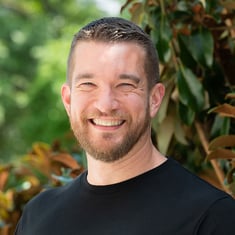The Butterfly Effect: Getting A Client 4 Years Later
Share this
My first job out of college was working with a financial planner that had been a real estate agent for many years.
One day he said, “Alan, I used to know that if I gave out 20 business cards, I would get 3 leads, which turned into 1 sale. If I gave a presentation on real estate, I would get 3 sales. It just isn’t like that anymore.”
What my boss was saying was that we have made a colossal shift from transactional 1-to-1 marketing, to relationship marketing. But what does this mean?
Before we talk about the power of relationships, let me tell you a story of how I got a client 4 years after a relationship was formed.
The Importance of Building and Maintaining a Network of Genuine Connections
In 2010, I was studying for my Master’s Degree in Family Financial Planning at The University of Georgia. I applied for a graduate student scholarship to attend a NAPFA National conference (where landed my first job by meeting the planner mentioned above). The chair of the scholarship committee was Jessica Smith, a financial planner in Huntsville, Alabama. She served as my mentor at the conference, introducing me to a lot of financial planners, but more importantly she got to know me and learned what I wanted to do in financial planning.
The next year, Jessica was serving on the first board for NAPFA Genesis, the sub-group of NAPFA for members 33 and under, but needed to step down. She told the then-chair of NAPFA Genesis Dave Grant that she thought I would be a good fit for the position.
Dave called me that week and asked if I would serve, and I agreed. Over the next year, Dave and I became friends and worked together on various projects for NAPFA Genesis.
When I ultimately launched my own RIA in August 2012, Dave was (and still is) writing a column for Financial Planning the Magazine on topics for next generation advisors. He wrote an article profiling 5 under-30 financial planners, with me being one of them.
In October 2013, Maggie McGrath, a reporter for Forbes, called me to see if I would help her out with a story on 6 Tough Money Choices For Millennials. She had found Dave’s article by doing a Google search for young advisors, so she thought I might be able to help.
In March of 2014, I had a prospective client schedule an introductory meeting and said he found me by reading Maggie’s article, and thought I would be a good fit, and they signed on as a client.
So in short, a relationship with the head of a scholarship committee in 2010 got me a client in 2014 -- not solely because I simply knew these people, but had formed a sincere relationship with each and every one of them.
Can You Measure Return on Relationship?
This is just one example of how my time on the NAPFA Genesis Board has benefited me professionally. I have met literally hundreds of other advisors, co-founded a network geared towards young planners, and made lifelong friends in the process.
In financial planning, we talk a lot about Return On Investment, or ROI. But how can we measure the ROR, or Return on Relationship?
When my mentor said that he knew how many business cards he needed to give out in order to sell a house, we was looking at the ROI of his time and energy handing out business cards.
10 cards, 1 sale: it really was that simple.
Today, people want to know, “how many blog posts do I need to write to get a client?” or, “how long will it take me to land a prospect on Twitter?” They want to know how much work they need to do to get a client
The answer? As you can guess, there isn’t one.
The Butterfly Effect of Your Present Actions
Today, marketing comes in the form of building and cultivating relationships. Whether you are building a relationship with the readers of your blog, Twitter followers, or connecting with reporters, ultimately the relationships you invest in today will determine your success as a financial planner.
As referenced in the title, the Butterfly Effect refers to small changes today having a large impact later in life. The theory proposes that a small incident in one area can set off a chain of events that ends in a exponentially larger incident in a completely different area -- like a butterfly flapping its wings in Texas causing a hurricane that hits China several weeks later.
Similarly, a tweet today may ultimately land you a job tomorrow.
How to Encourage Small Actions to Develop into Major Milestones
I hate it when people tell me what I need to do without actually telling me how to do it, so I won't leave you hanging here.
Check out these tips to help you get started in building relationships today that could have a huge, positive impact on your professional life somewhere down the road:
- Get involved with a young advisor network, such as NAPFA Genesis and FPA NexGen (or, you know, the XY Planning Network. I hear they have amazing members). Get to know your peers, and help them every chance you can.
- Get on social media, particularly Twitter. Financial planners and members of the financial media LOVE twitter, so you need to be there. If your compliance officer says you can’t be on social media, you can simply listen and then interact offline with advisors/members of the media… then find a new compliance officer. Seriously, if compliance says no social media, dump them.
- Check out success stories from young advisors building relationships, some even before graduation. Check out Derek Lawson as a case study for doing this the right way (and then follow the above tip and connect with him on Twitter).
- Recognize that you never know how a relationship might benefit you one day, so take every chance you can to cultivate sincere, genuine connections with people. If you run into someone you're not fond of, maintain your professionalism and be courteous no matter what. And whatever you do, don’t burn bridges. Ever.

About the Author
Alan Moore is the CEO and Co-Founder of XY Planning Network—a support ecosystem dedicated to helping fee-for-service advisors start, run, and grow their own financial planning firms and serve the clients they want. His favorite part about his job is dreaming about possibilities for what's next, knowing his stellar team will either tell him no or Get Sh*t Done to make it happen.
Share this
- Fee-only advisor (381)
- Advice (305)
- Business Development (248)
- Independent Financial Advisor (203)
- Growing Your Firm (161)
- Marketing (133)
- Financial Planning (129)
- What Would Arlene Say (WWAS) (81)
- Business Coach (80)
- Firm Ownership (78)
- Training (75)
- Compliance (72)
- Business (69)
- Building Your Firm (65)
- Financial Advisors (63)
- Online Marketing (61)
- Events (59)
- Starting a Firm (52)
- Staffing & HR (49)
- Technology (49)
- From XYPN Members (48)
- Launching a firm (46)
- Advisors (41)
- Entrepreneurship (38)
- Taxes (37)
- Networking & Community (33)
- Interviews and Case Studies (32)
- Investment Management (31)
- Sales (27)
- Social Responsibility (27)
- Tax Preparation (27)
- XYPN Invest (26)
- Business Owner (25)
- Small Business Owner (20)
- Financial Management & Investment (19)
- Industry Trends & Insights (19)
- Financial Education (17)
- Financial Planners (17)
- Independent Financial Planner (17)
- Tech Stack (17)
- XYPN (17)
- Leadership & Vision (16)
- Investing (15)
- Niche (15)
- How to be a Financial Advisor (14)
- NextGen (14)
- RIA (14)
- Media (13)
- Preparing to Launch (13)
- Press Mentions (13)
- RIA Operations (12)
- RIA Owner (12)
- XYPN Membership (12)
- Assets Under Management (AUM) (11)
- First Year (11)
- Goals (11)
- Scaling (10)
- Advisor Success (9)
- Building Your Firm (8)
- Communication (8)
- Lessons (8)
- Study Group (8)
- Time Management (8)
- Virtual Advisor (8)
- Behavioral Finance (7)
- Growth (7)
- Pricing Models (7)
- From Our Advisors (6)
- Independent RIA (6)
- Money Management (6)
- Motivation (6)
- Processes (6)
- Automation (5)
- Broker-Dealers (5)
- College Planning (5)
- Filing Status (5)
- How I Did It series (5)
- Investment Planner (5)
- Mental Health (5)
- Michael Kitces (5)
- Preparing to Launch (5)
- RIA Operations (5)
- Retirement (5)
- Risk and Investing (5)
- S Corpration (5)
- Support System (5)
- TAMP (5)
- Wealth (5)
- Year-End (5)
- Client Services (4)
- Outsourcing (4)
- Selling a Firm (4)
- Succession Plans (4)
- Benchmarking Study (3)
- Budgeting (3)
- Career Changers (3)
- Engagement (3)
- Fiduciary (3)
- Getting Leads (3)
- Membership (3)
- Millennials (3)
- Monthly Retainer Model (3)
- Partnership (3)
- Pricing (3)
- Recordkeeping (3)
- Risk Assessment (3)
- Small Business (3)
- Staying Relevant (3)
- Work Life Balance (3)
- Advice-Only Planning (2)
- Bookkeeping (2)
- Charitable Donations (2)
- Client Acquisition (2)
- Differentiation (2)
- Health Care (2)
- IRA (2)
- Inflation (2)
- Productivity (2)
- Implementing (1)
Subscribe by email
You May Also Like
These Related Stories

5 Simple Secrets of Effective Prospect Nurturing

How Marketing Can Help You Build a Firm for the Future



